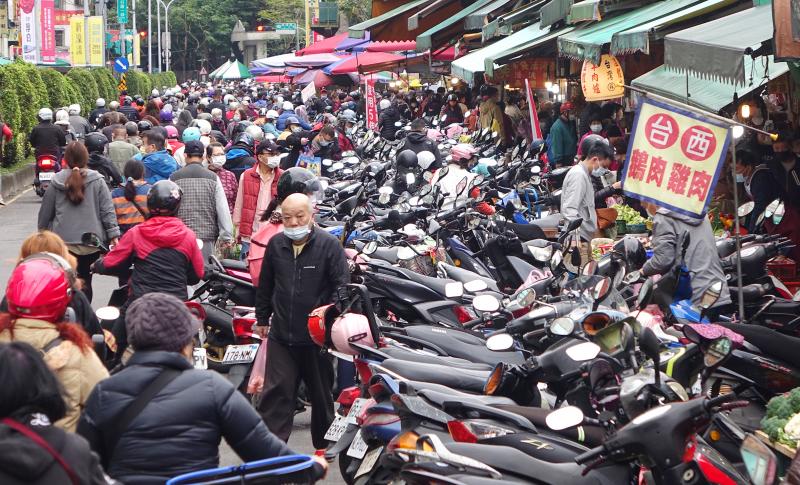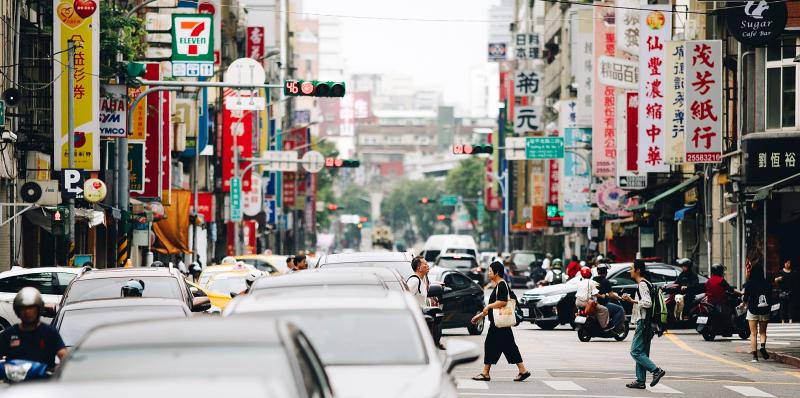Last month, the Ministry of the Interior announced that last year was the second year since accurate recordkeeping began in which Taiwan’s population was smaller at the end of the year than it was at the start.
The decline in 2020 wasn’t considerable, roughly equal to the total number of inhabitants of Rueifang District (瑞芳) in New Taipei City.
Last year, however, the country’s population fell by almost 186,000 people to 23.375 million. It’s as if everyone in New Taipei City’s Tamsui District (淡水) disappeared.

Photo: Liu Hsin-de, Times Times
This is a downward trend, not a blip. In last year’s Oct. 31 issue, Win Win Weekly, a Chinese-language magazine, boasted that, back in 2004, it was the first media to highlight both the scale (“a loss of 5 million people”) and the imminence (“In 2050, 40 percent of Taiwanese will be 65 or older… there’ll be just 1.4 young people to support each elderly person”) of Taiwan’s looming demographic crisis.
AGING POPULATION
In Taiwan as in other countries, the prospect of a rapidly aging population is almost always viewed through the lens of economics.

Photo: Liu Yu-ching, Taipei Times
Taiwan may suffer from a shrinking talent pool and fewer consumers, observers say. The military may struggle even more than it does currently to attract recruits. The government will come under pressure to provide better health and welfare services; even if taxes go up, finding staff for hospitals and care facilities could be near impossible.
In an Oct. 11, 2020 op-ed for this newspaper, Contemporary Taiwan Development Foundation Vice Chairman Lee Shen-yi (李伸一) predicted that the population’s rapid aging would have “a deleterious effect on Taiwan’s economy and society, to the extent that it is elevated to a national security problem.”
On Jan. 15, the Taipei Times editorial urged the government to “act fast to tackle the declining birthrate.”

Photo: Pixabay
Yet, a recent paper co-written by 17 scholars from Japan, Sweden, Germany and South Africa points out that such demographic changes are also an opportunity to implement the UN’s sustainable development goals (SDGs).
In the paper — “Aging and Population Shrinking: Implications for Sustainability in the Urban Century” and published on May 27 last year in Urban Sustainability — they say that “the dimensions, dynamics and consequences of simultaneous aging and shrinking populations are by and large overlooked” in UN documents setting out SDGs.
In countries where the population is getting older and smaller, they see “multiple positive and negative ramifications for sustainability, in terms of economic growth, public sector development, consumption patterns, land use change and greenhouse gas emissions.”
A drop in human population, the paper states, may benefit biodiversity conservation and ecosystem functioning. This is because total consumption is likely to fall, which in turn should reduce pressure to convert natural areas for housing, industry or agriculture.
However, Taiwan’s recent history suggests that, if citizens don’t spend as much as before, and businesspeople complain, the government may try to make up the shortfall through investments in infrastructure. Very often, such projects involve pouring concrete and paving over green fields.
There are fewer people than before, yet housebuilding and urban sprawl continue apace. One reason for this is that adult Taiwanese are less inclined to live with their parents and grandparents. It’s also becoming more difficult to stay at home, because good jobs are seldom nearby. What’s more, the tax system favors speculative investments in houses and apartments.
People of retirement age don’t need to commute, but they do require a lot more medical treatment than younger people. In every country, healthcare generates a lot of greenhouse gases, and a huge amount of plastic waste.
PEAK CAR?
Taiwan still feels very crowded, and not just with people. The era of population expansion is over, probably for good, yet it doesn’t look like society has reached “peak car” or “peak motorcycle.”
Last year, Taiwan added 300,000 motor vehicles to its roads. Car registrations rose 137,537 to 8.33 million, while the number of motorcycles grew 163,157 to 14.27 million. Car numbers have quadrupled since 1988, and there are twice as many motorcycles now as in 1990.
Per capita distance traveled by privately-owned motor vehicle is perhaps a more meaningful metric. In Taiwan, it isn’t clear if this has increased or not. The average number of kilometers driven by residents of Japan, much of northern Europe and some parts of the US appears to have dropped since the 1990s, even allowing for fluctuating employment levels. However, it’s reasonable to assume that no one splashes out on a Toyota or a Gogoro intending for it to gather dust in their garage. Also, fear of COVID-19 is sure to have pushed some people away from public transportation.
An aging population won’t necessarily depress private vehicle use, even with the billions of dollars that are being invested in public transportation.
Sooner or later, Taiwan’s government will allow self-driving cars. Senior citizens who like the convenience of having their own vehicle, but who feel their eyesight or reactions aren’t what they used to be, are likely to make use of this technology.
Perhaps the key factor — and this is highly relevant to Taiwan — is whether or not the authorities continue to respond to road congestion by devoting ever more space to motor vehicles.
Building new roads or widening existing ones, it’s now obvious, simply increases people’s enthusiasm for driving.
According to a Jun. 17, 2014, article in Wired, creating better road links encourages people to live farther from their workplace, to use their cars more often and to establish businesses that depend on trucked supplies: “These things together erode any extra capacity you’ve built into your street network, meaning traffic levels stay pretty much constant. As long as driving on the roads remains easy and cheap, people have an almost unlimited desire to use them.”
Citizen of the Earth, Taiwan Deputy Executive Director Tsai Chung-yueh (蔡中岳) has recognized this. Writing in an Aug. 14, 2015 op-ed for United Daily News, he noted that, “in the face of traffic congestion in Taiwan, widening is almost the only answer. However, for popular scenic spots, no matter how much road capacity is increased, it’s never enough.”
Concluding that road improvements tend to draw even more traffic to a destination (a phenomenon known to scholars as “induced demand”), Tsai called for an imaginative and diverse approach to traffic issues.
Surprisingly, induced demand appears to also work in reverse. The Wired article cites Paris, San Francisco and Seoul as places where roads have been significantly downsized without any noticeable deterioration in driving conditions.
The South Korean capital, Wired reports, “tore down a highway that was considered a vital roadway corridor, carrying 168,000 cars per day. After replacing the cars with a river, parkland and some smaller roads, traffic didn’t get worse and many other things, including pollution, got better.”
Rather than spend an estimated NT$6.49 billion to build the 5.45km-long Tambei Expressway (淡北快速道路) between Beitou (北投) and Tamsui — and billions more on similar projects — the country should leverage demographic changes so as to kick it’s damaging car-and-scooter addiction.
This would be a major step toward a more sustainable society. But without a change of direction at the highest levels, it’s hard to see how it’ll happen.
Steven Crook, the author or co-author of four books about Taiwan, has been following environmental issues since he arrived in the country in 1991. He drives a hybrid and carries his own chopsticks. The views expressed here are his own.

June 2 to June 8 Taiwan’s woodcutters believe that if they see even one speck of red in their cooked rice, no matter how small, an accident is going to happen. Peng Chin-tian (彭錦田) swears that this has proven to be true at every stop during his decades-long career in the logging industry. Along with mining, timber harvesting was once considered the most dangerous profession in Taiwan. Not only were mishaps common during all stages of processing, it was difficult to transport the injured to get medical treatment. Many died during the arduous journey. Peng recounts some of his accidents in

“Why does Taiwan identity decline?”a group of researchers lead by University of Nevada political scientist Austin Wang (王宏恩) asked in a recent paper. After all, it is not difficult to explain the rise in Taiwanese identity after the early 1990s. But no model predicted its decline during the 2016-2018 period, they say. After testing various alternative explanations, Wang et al argue that the fall-off in Taiwanese identity during that period is related to voter hedging based on the performance of the Democratic Progressive Party (DPP). Since the DPP is perceived as the guardian of Taiwan identity, when it performs well,

The Taiwan People’s Party (TPP) on May 18 held a rally in Taichung to mark the anniversary of President William Lai’s (賴清德) inauguration on May 20. The title of the rally could be loosely translated to “May 18 recall fraudulent goods” (518退貨ㄌㄨㄚˋ!). Unlike in English, where the terms are the same, “recall” (退貨) in this context refers to product recalls due to damaged, defective or fraudulent merchandise, not the political recalls (罷免) currently dominating the headlines. I attended the rally to determine if the impression was correct that the TPP under party Chairman Huang Kuo-Chang (黃國昌) had little of a

At Computex 2025, Nvidia CEO Jensen Huang (黃仁勳) urged the government to subsidize AI. “All schools in Taiwan must integrate AI into their curricula,” he declared. A few months earlier, he said, “If I were a student today, I’d immediately start using tools like ChatGPT, Gemini Pro and Grok to learn, write and accelerate my thinking.” Huang sees the AI-bullet train leaving the station. And as one of its drivers, he’s worried about youth not getting on board — bad for their careers, and bad for his workforce. As a semiconductor supply-chain powerhouse and AI hub wannabe, Taiwan is seeing